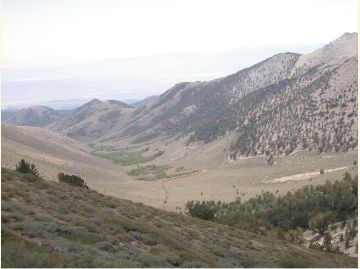

elevation), the route climbs the ridgeline to the south towards an unnamed 12,200 ft. 3 miles, crosses to the south side of the canyon, and continues up to the saddle. The use trail continues up canyon for about. The most direct use trail to the saddle starts along the base of the north side of the canyon near the lowest elevation pines in the drainage. The route to the peak continues towards Trail Canyon saddle. From the meadow, you may see the use trail that descends from the peak’s northeast drainage. The rest of the route is on informal “use trails”: trails that are not constructed but formed through repeated travel by hikers. The system trail ends in a meadow at 9,800 ft.

Surface water is available from a small stream the first mile of the route. The first 1.7 miles of the route are along the Forest Service system trail on the south side of the canyon. The Trail Canyon Route is approximatley 8.5 miles round trip. You need to have route finding and cross-country navigation skills, and we recommend acclimating to altitude for several days before undertaking this hike. The hike to the summit of Boundary Peak is most often done as a long day hike. From the summit, the view takes in the Mono Lake basin to the north, the Sierra Nevada Mountains to the west, the White Mountains Wilderness to the south, while Nevada’s Basin and Range extends to the eastern horizon. Trail Canyon Trail provides access to Boundary Peak, the highest point in Nevada at 13,140 feet.


 0 kommentar(er)
0 kommentar(er)
